HBS108: Flavonoids and AMD - Interpreting Health Research Evidence
VerifiedAdded on 2023/06/07
|10
|1836
|227
Homework Assignment
AI Summary
This assignment provides a comprehensive analysis of the relationship between dietary flavonoids and age-related macular degeneration (AMD), based on a research article by Gopinath et al. (2018) and a news report by Logan (2018). The study design is identified as a population-based cohort study with cross-sectional analysis, and the independent and dependent variables are determined to be flavonoids and AMD, respectively. The assignment addresses potential biases such as confounding and information bias, as well as the scale of measurement used in the study. It explains the concepts of incidence and prevalence, factors controlled in the study, and the use of odds ratios and confidence intervals in measuring the association between flavonoid intake and AMD. The accuracy of the news article is evaluated based on the research findings, and the Bradford-Hill criteria are applied to assess the causal relationship between flavonoid consumption and AMD. Finally, the assignment suggests further research, such as prospective cohort and epidemiological studies, to strengthen the evidence and discusses potential challenges in conducting such studies. The student paper is available on Desklib, a platform that provides a comprehensive suite of AI-powered study tools.
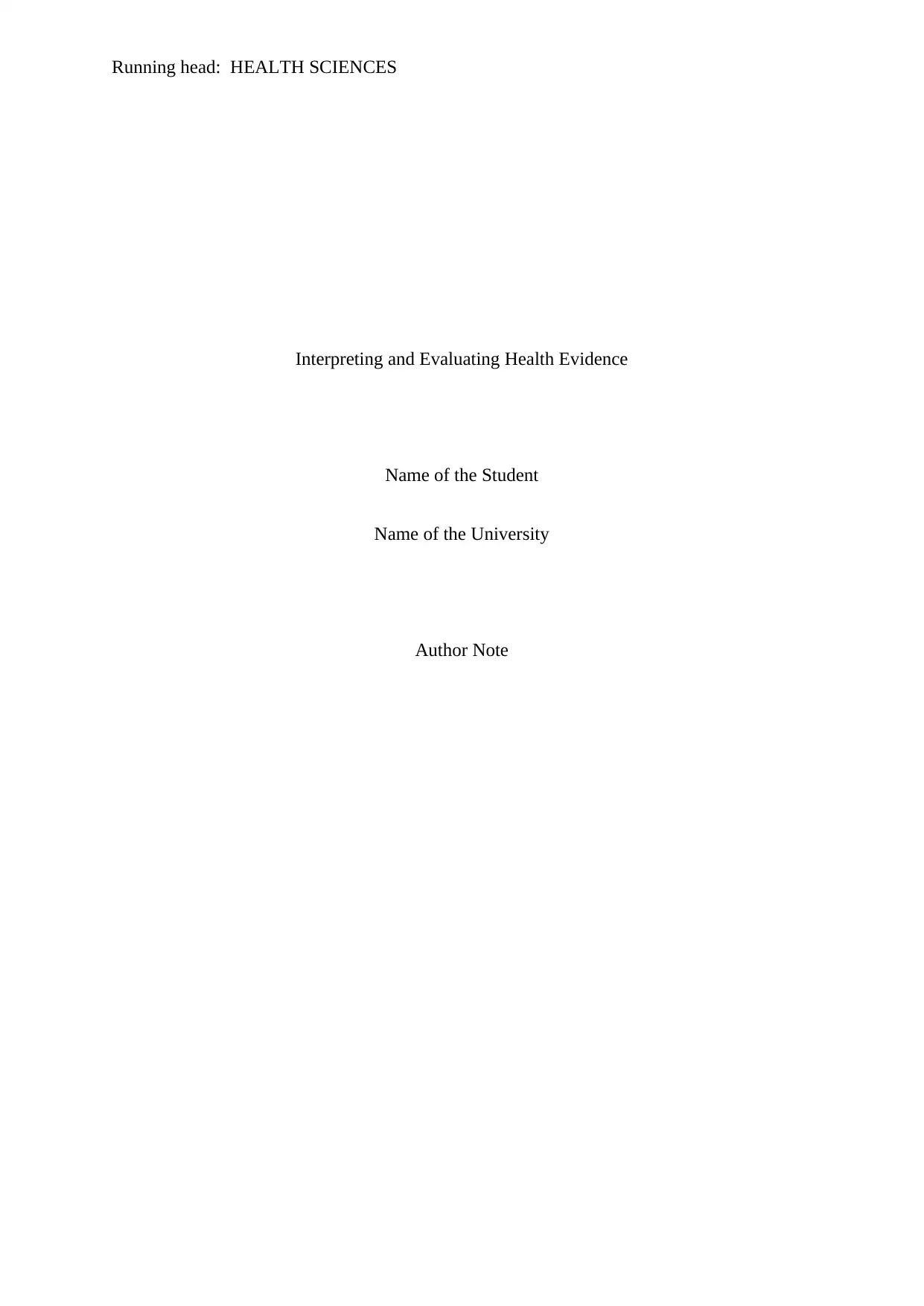
Running head: HEALTH SCIENCES
Interpreting and Evaluating Health Evidence
Name of the Student
Name of the University
Author Note
Interpreting and Evaluating Health Evidence
Name of the Student
Name of the University
Author Note
Paraphrase This Document
Need a fresh take? Get an instant paraphrase of this document with our AI Paraphraser
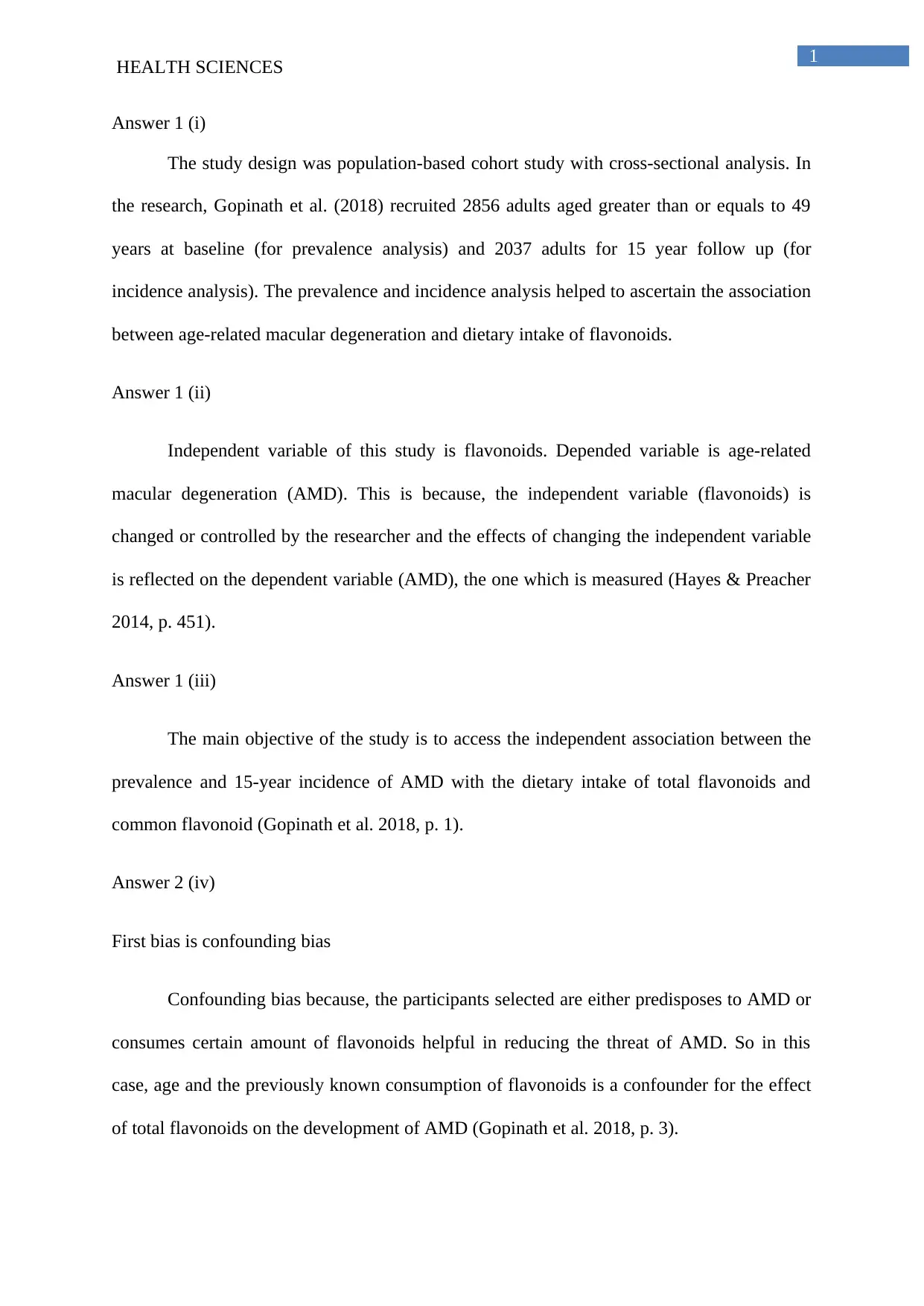
1
HEALTH SCIENCES
Answer 1 (i)
The study design was population-based cohort study with cross-sectional analysis. In
the research, Gopinath et al. (2018) recruited 2856 adults aged greater than or equals to 49
years at baseline (for prevalence analysis) and 2037 adults for 15 year follow up (for
incidence analysis). The prevalence and incidence analysis helped to ascertain the association
between age-related macular degeneration and dietary intake of flavonoids.
Answer 1 (ii)
Independent variable of this study is flavonoids. Depended variable is age-related
macular degeneration (AMD). This is because, the independent variable (flavonoids) is
changed or controlled by the researcher and the effects of changing the independent variable
is reflected on the dependent variable (AMD), the one which is measured (Hayes & Preacher
2014, p. 451).
Answer 1 (iii)
The main objective of the study is to access the independent association between the
prevalence and 15-year incidence of AMD with the dietary intake of total flavonoids and
common flavonoid (Gopinath et al. 2018, p. 1).
Answer 2 (iv)
First bias is confounding bias
Confounding bias because, the participants selected are either predisposes to AMD or
consumes certain amount of flavonoids helpful in reducing the threat of AMD. So in this
case, age and the previously known consumption of flavonoids is a confounder for the effect
of total flavonoids on the development of AMD (Gopinath et al. 2018, p. 3).
HEALTH SCIENCES
Answer 1 (i)
The study design was population-based cohort study with cross-sectional analysis. In
the research, Gopinath et al. (2018) recruited 2856 adults aged greater than or equals to 49
years at baseline (for prevalence analysis) and 2037 adults for 15 year follow up (for
incidence analysis). The prevalence and incidence analysis helped to ascertain the association
between age-related macular degeneration and dietary intake of flavonoids.
Answer 1 (ii)
Independent variable of this study is flavonoids. Depended variable is age-related
macular degeneration (AMD). This is because, the independent variable (flavonoids) is
changed or controlled by the researcher and the effects of changing the independent variable
is reflected on the dependent variable (AMD), the one which is measured (Hayes & Preacher
2014, p. 451).
Answer 1 (iii)
The main objective of the study is to access the independent association between the
prevalence and 15-year incidence of AMD with the dietary intake of total flavonoids and
common flavonoid (Gopinath et al. 2018, p. 1).
Answer 2 (iv)
First bias is confounding bias
Confounding bias because, the participants selected are either predisposes to AMD or
consumes certain amount of flavonoids helpful in reducing the threat of AMD. So in this
case, age and the previously known consumption of flavonoids is a confounder for the effect
of total flavonoids on the development of AMD (Gopinath et al. 2018, p. 3).
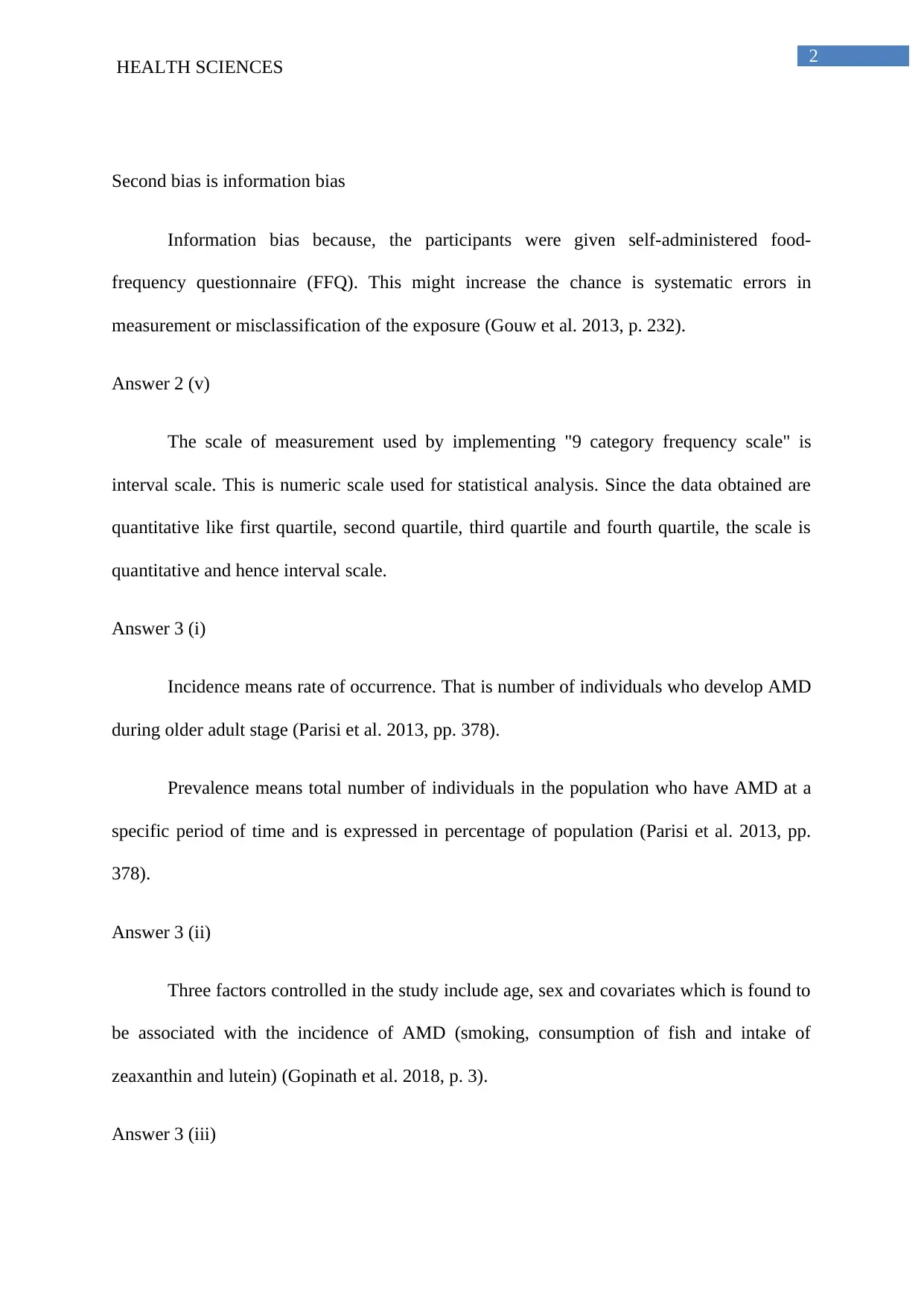
2
HEALTH SCIENCES
Second bias is information bias
Information bias because, the participants were given self-administered food-
frequency questionnaire (FFQ). This might increase the chance is systematic errors in
measurement or misclassification of the exposure (Gouw et al. 2013, p. 232).
Answer 2 (v)
The scale of measurement used by implementing "9 category frequency scale" is
interval scale. This is numeric scale used for statistical analysis. Since the data obtained are
quantitative like first quartile, second quartile, third quartile and fourth quartile, the scale is
quantitative and hence interval scale.
Answer 3 (i)
Incidence means rate of occurrence. That is number of individuals who develop AMD
during older adult stage (Parisi et al. 2013, pp. 378).
Prevalence means total number of individuals in the population who have AMD at a
specific period of time and is expressed in percentage of population (Parisi et al. 2013, pp.
378).
Answer 3 (ii)
Three factors controlled in the study include age, sex and covariates which is found to
be associated with the incidence of AMD (smoking, consumption of fish and intake of
zeaxanthin and lutein) (Gopinath et al. 2018, p. 3).
Answer 3 (iii)
HEALTH SCIENCES
Second bias is information bias
Information bias because, the participants were given self-administered food-
frequency questionnaire (FFQ). This might increase the chance is systematic errors in
measurement or misclassification of the exposure (Gouw et al. 2013, p. 232).
Answer 2 (v)
The scale of measurement used by implementing "9 category frequency scale" is
interval scale. This is numeric scale used for statistical analysis. Since the data obtained are
quantitative like first quartile, second quartile, third quartile and fourth quartile, the scale is
quantitative and hence interval scale.
Answer 3 (i)
Incidence means rate of occurrence. That is number of individuals who develop AMD
during older adult stage (Parisi et al. 2013, pp. 378).
Prevalence means total number of individuals in the population who have AMD at a
specific period of time and is expressed in percentage of population (Parisi et al. 2013, pp.
378).
Answer 3 (ii)
Three factors controlled in the study include age, sex and covariates which is found to
be associated with the incidence of AMD (smoking, consumption of fish and intake of
zeaxanthin and lutein) (Gopinath et al. 2018, p. 3).
Answer 3 (iii)
⊘ This is a preview!⊘
Do you want full access?
Subscribe today to unlock all pages.

Trusted by 1+ million students worldwide

3
HEALTH SCIENCES
HEALTH SCIENCES
Paraphrase This Document
Need a fresh take? Get an instant paraphrase of this document with our AI Paraphraser
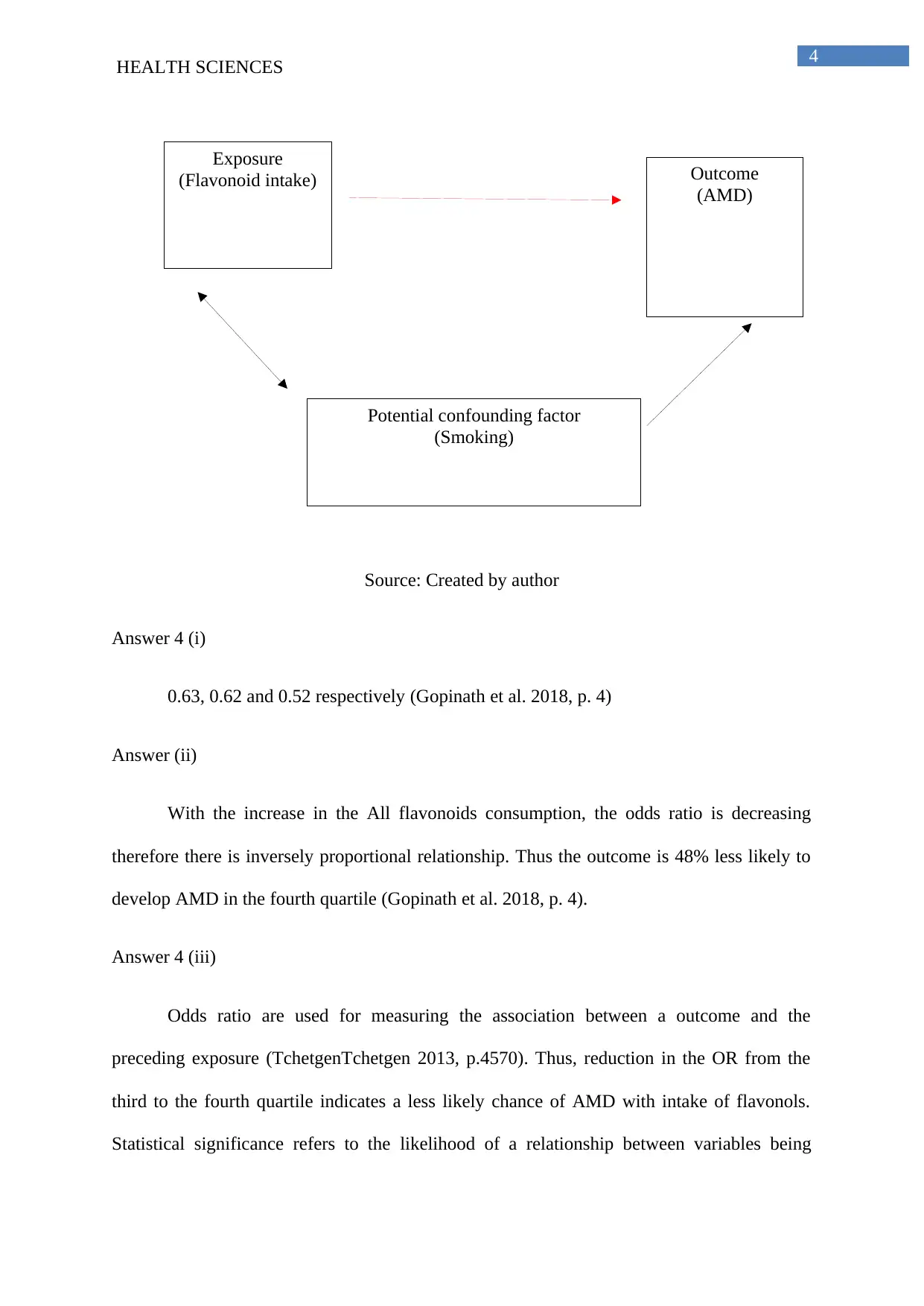
4
Exposure
(Flavonoid intake) Outcome
(AMD)
Potential confounding factor
(Smoking)
HEALTH SCIENCES
Source: Created by author
Answer 4 (i)
0.63, 0.62 and 0.52 respectively (Gopinath et al. 2018, p. 4)
Answer (ii)
With the increase in the All flavonoids consumption, the odds ratio is decreasing
therefore there is inversely proportional relationship. Thus the outcome is 48% less likely to
develop AMD in the fourth quartile (Gopinath et al. 2018, p. 4).
Answer 4 (iii)
Odds ratio are used for measuring the association between a outcome and the
preceding exposure (TchetgenTchetgen 2013, p.4570). Thus, reduction in the OR from the
third to the fourth quartile indicates a less likely chance of AMD with intake of flavonols.
Statistical significance refers to the likelihood of a relationship between variables being
Exposure
(Flavonoid intake) Outcome
(AMD)
Potential confounding factor
(Smoking)
HEALTH SCIENCES
Source: Created by author
Answer 4 (i)
0.63, 0.62 and 0.52 respectively (Gopinath et al. 2018, p. 4)
Answer (ii)
With the increase in the All flavonoids consumption, the odds ratio is decreasing
therefore there is inversely proportional relationship. Thus the outcome is 48% less likely to
develop AMD in the fourth quartile (Gopinath et al. 2018, p. 4).
Answer 4 (iii)
Odds ratio are used for measuring the association between a outcome and the
preceding exposure (TchetgenTchetgen 2013, p.4570). Thus, reduction in the OR from the
third to the fourth quartile indicates a less likely chance of AMD with intake of flavonols.
Statistical significance refers to the likelihood of a relationship between variables being
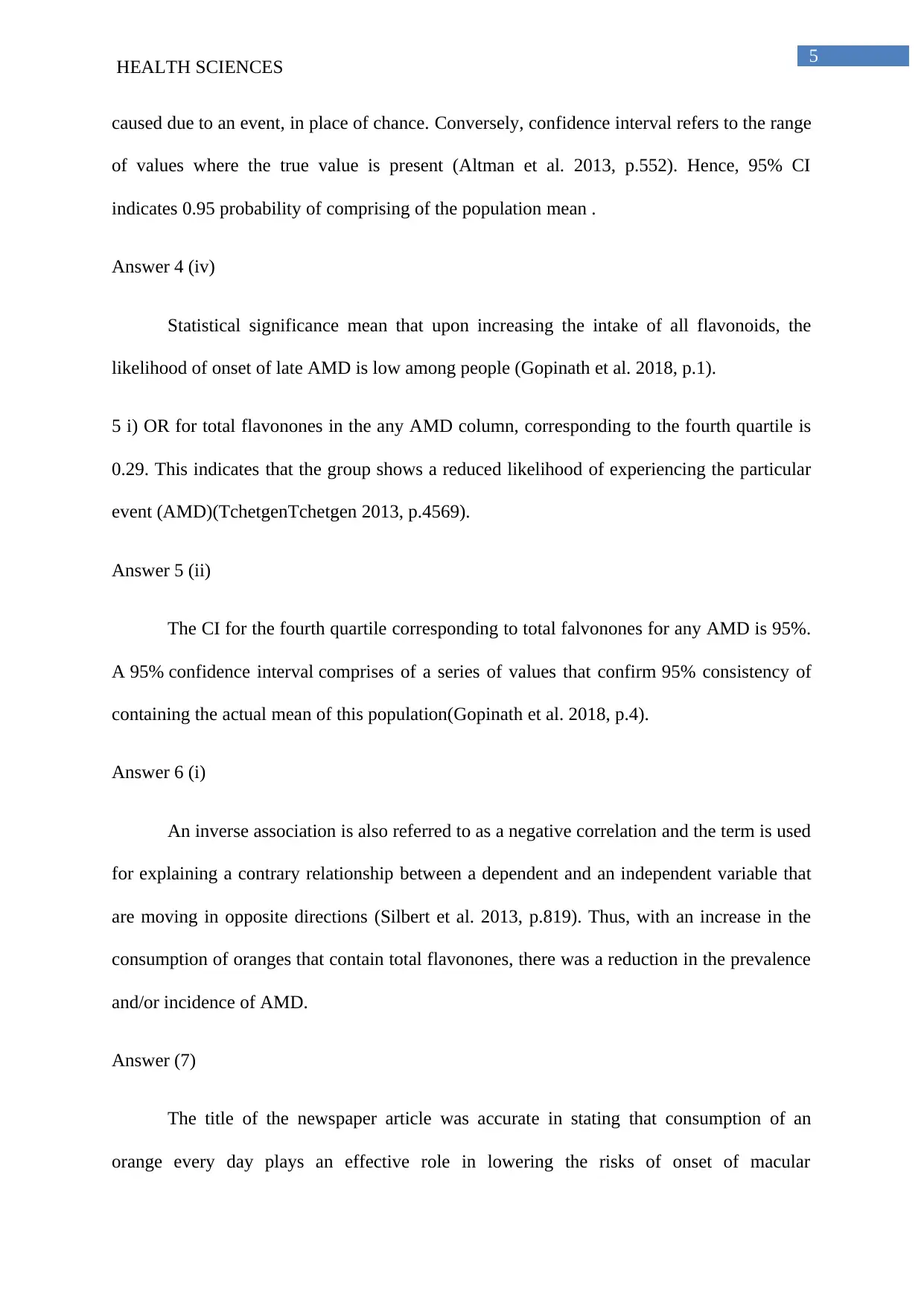
5
HEALTH SCIENCES
caused due to an event, in place of chance. Conversely, confidence interval refers to the range
of values where the true value is present (Altman et al. 2013, p.552). Hence, 95% CI
indicates 0.95 probability of comprising of the population mean .
Answer 4 (iv)
Statistical significance mean that upon increasing the intake of all flavonoids, the
likelihood of onset of late AMD is low among people (Gopinath et al. 2018, p.1).
5 i) OR for total flavonones in the any AMD column, corresponding to the fourth quartile is
0.29. This indicates that the group shows a reduced likelihood of experiencing the particular
event (AMD)(TchetgenTchetgen 2013, p.4569).
Answer 5 (ii)
The CI for the fourth quartile corresponding to total falvonones for any AMD is 95%.
A 95% confidence interval comprises of a series of values that confirm 95% consistency of
containing the actual mean of this population(Gopinath et al. 2018, p.4).
Answer 6 (i)
An inverse association is also referred to as a negative correlation and the term is used
for explaining a contrary relationship between a dependent and an independent variable that
are moving in opposite directions (Silbert et al. 2013, p.819). Thus, with an increase in the
consumption of oranges that contain total flavonones, there was a reduction in the prevalence
and/or incidence of AMD.
Answer (7)
The title of the newspaper article was accurate in stating that consumption of an
orange every day plays an effective role in lowering the risks of onset of macular
HEALTH SCIENCES
caused due to an event, in place of chance. Conversely, confidence interval refers to the range
of values where the true value is present (Altman et al. 2013, p.552). Hence, 95% CI
indicates 0.95 probability of comprising of the population mean .
Answer 4 (iv)
Statistical significance mean that upon increasing the intake of all flavonoids, the
likelihood of onset of late AMD is low among people (Gopinath et al. 2018, p.1).
5 i) OR for total flavonones in the any AMD column, corresponding to the fourth quartile is
0.29. This indicates that the group shows a reduced likelihood of experiencing the particular
event (AMD)(TchetgenTchetgen 2013, p.4569).
Answer 5 (ii)
The CI for the fourth quartile corresponding to total falvonones for any AMD is 95%.
A 95% confidence interval comprises of a series of values that confirm 95% consistency of
containing the actual mean of this population(Gopinath et al. 2018, p.4).
Answer 6 (i)
An inverse association is also referred to as a negative correlation and the term is used
for explaining a contrary relationship between a dependent and an independent variable that
are moving in opposite directions (Silbert et al. 2013, p.819). Thus, with an increase in the
consumption of oranges that contain total flavonones, there was a reduction in the prevalence
and/or incidence of AMD.
Answer (7)
The title of the newspaper article was accurate in stating that consumption of an
orange every day plays an effective role in lowering the risks of onset of macular
⊘ This is a preview!⊘
Do you want full access?
Subscribe today to unlock all pages.

Trusted by 1+ million students worldwide
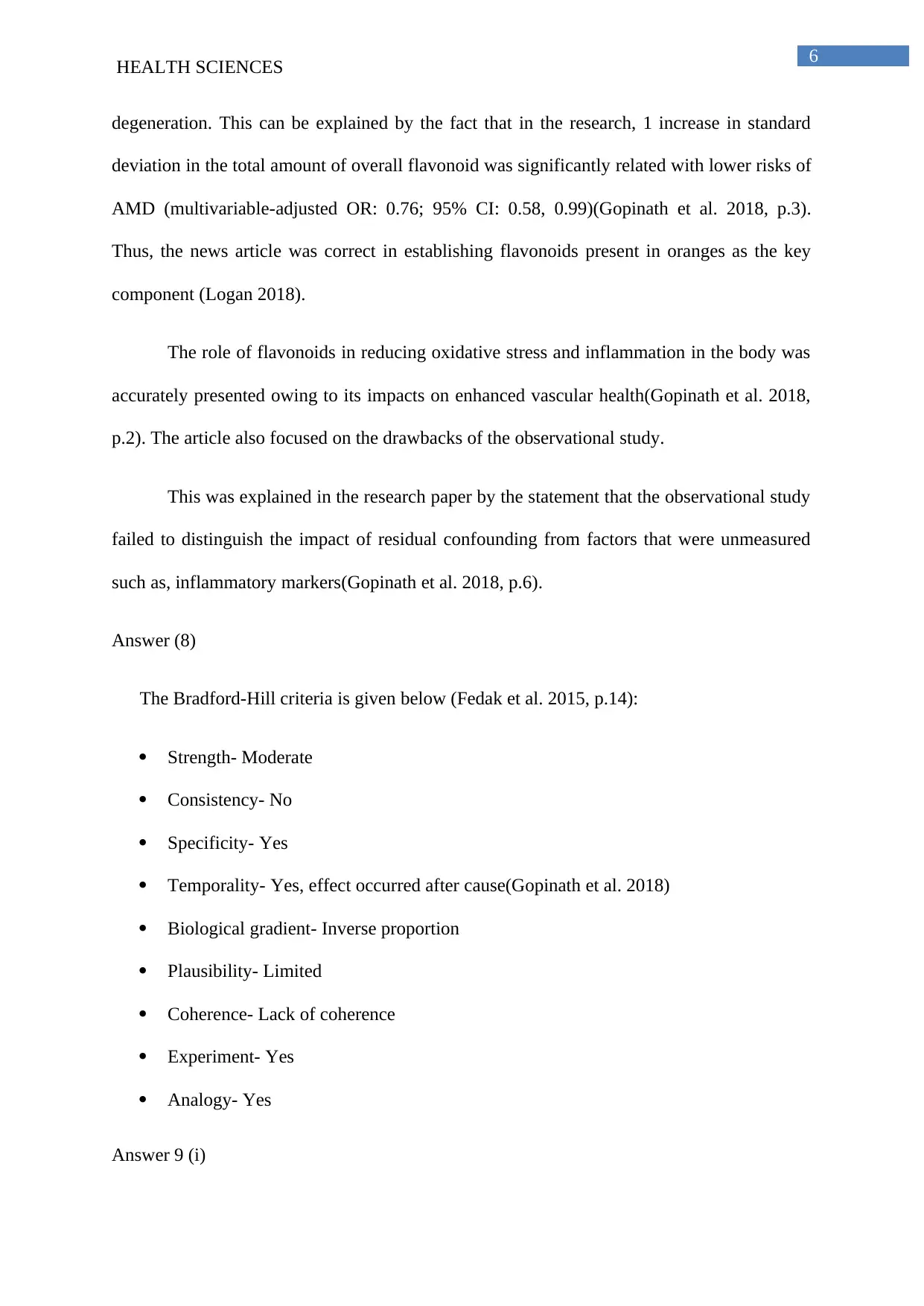
6
HEALTH SCIENCES
degeneration. This can be explained by the fact that in the research, 1 increase in standard
deviation in the total amount of overall flavonoid was significantly related with lower risks of
AMD (multivariable-adjusted OR: 0.76; 95% CI: 0.58, 0.99)(Gopinath et al. 2018, p.3).
Thus, the news article was correct in establishing flavonoids present in oranges as the key
component (Logan 2018).
The role of flavonoids in reducing oxidative stress and inflammation in the body was
accurately presented owing to its impacts on enhanced vascular health(Gopinath et al. 2018,
p.2). The article also focused on the drawbacks of the observational study.
This was explained in the research paper by the statement that the observational study
failed to distinguish the impact of residual confounding from factors that were unmeasured
such as, inflammatory markers(Gopinath et al. 2018, p.6).
Answer (8)
The Bradford-Hill criteria is given below (Fedak et al. 2015, p.14):
Strength- Moderate
Consistency- No
Specificity- Yes
Temporality- Yes, effect occurred after cause(Gopinath et al. 2018)
Biological gradient- Inverse proportion
Plausibility- Limited
Coherence- Lack of coherence
Experiment- Yes
Analogy- Yes
Answer 9 (i)
HEALTH SCIENCES
degeneration. This can be explained by the fact that in the research, 1 increase in standard
deviation in the total amount of overall flavonoid was significantly related with lower risks of
AMD (multivariable-adjusted OR: 0.76; 95% CI: 0.58, 0.99)(Gopinath et al. 2018, p.3).
Thus, the news article was correct in establishing flavonoids present in oranges as the key
component (Logan 2018).
The role of flavonoids in reducing oxidative stress and inflammation in the body was
accurately presented owing to its impacts on enhanced vascular health(Gopinath et al. 2018,
p.2). The article also focused on the drawbacks of the observational study.
This was explained in the research paper by the statement that the observational study
failed to distinguish the impact of residual confounding from factors that were unmeasured
such as, inflammatory markers(Gopinath et al. 2018, p.6).
Answer (8)
The Bradford-Hill criteria is given below (Fedak et al. 2015, p.14):
Strength- Moderate
Consistency- No
Specificity- Yes
Temporality- Yes, effect occurred after cause(Gopinath et al. 2018)
Biological gradient- Inverse proportion
Plausibility- Limited
Coherence- Lack of coherence
Experiment- Yes
Analogy- Yes
Answer 9 (i)
Paraphrase This Document
Need a fresh take? Get an instant paraphrase of this document with our AI Paraphraser

7
HEALTH SCIENCES
Prospective cohort and/or epidemiological studies need to be conducted
Answer 9 (ii)
Prospective cohort studies will follow similar individuals over a time frame and
determine the changes in the dependent variable (AMD outcome) with respect to flavonoid
consumption. Epidemiological investigation will establish a link between risk factor and the
incidence of disease that is being investigated (AMD)
Answer 9 (iii)
Some of the challenges that might be encountered are as follows:
Following large number of sample for long duration
Time consuming and expensive
Differential loss might lead to bias
Constraints due to sudden changes in nutritional status and health
HEALTH SCIENCES
Prospective cohort and/or epidemiological studies need to be conducted
Answer 9 (ii)
Prospective cohort studies will follow similar individuals over a time frame and
determine the changes in the dependent variable (AMD outcome) with respect to flavonoid
consumption. Epidemiological investigation will establish a link between risk factor and the
incidence of disease that is being investigated (AMD)
Answer 9 (iii)
Some of the challenges that might be encountered are as follows:
Following large number of sample for long duration
Time consuming and expensive
Differential loss might lead to bias
Constraints due to sudden changes in nutritional status and health
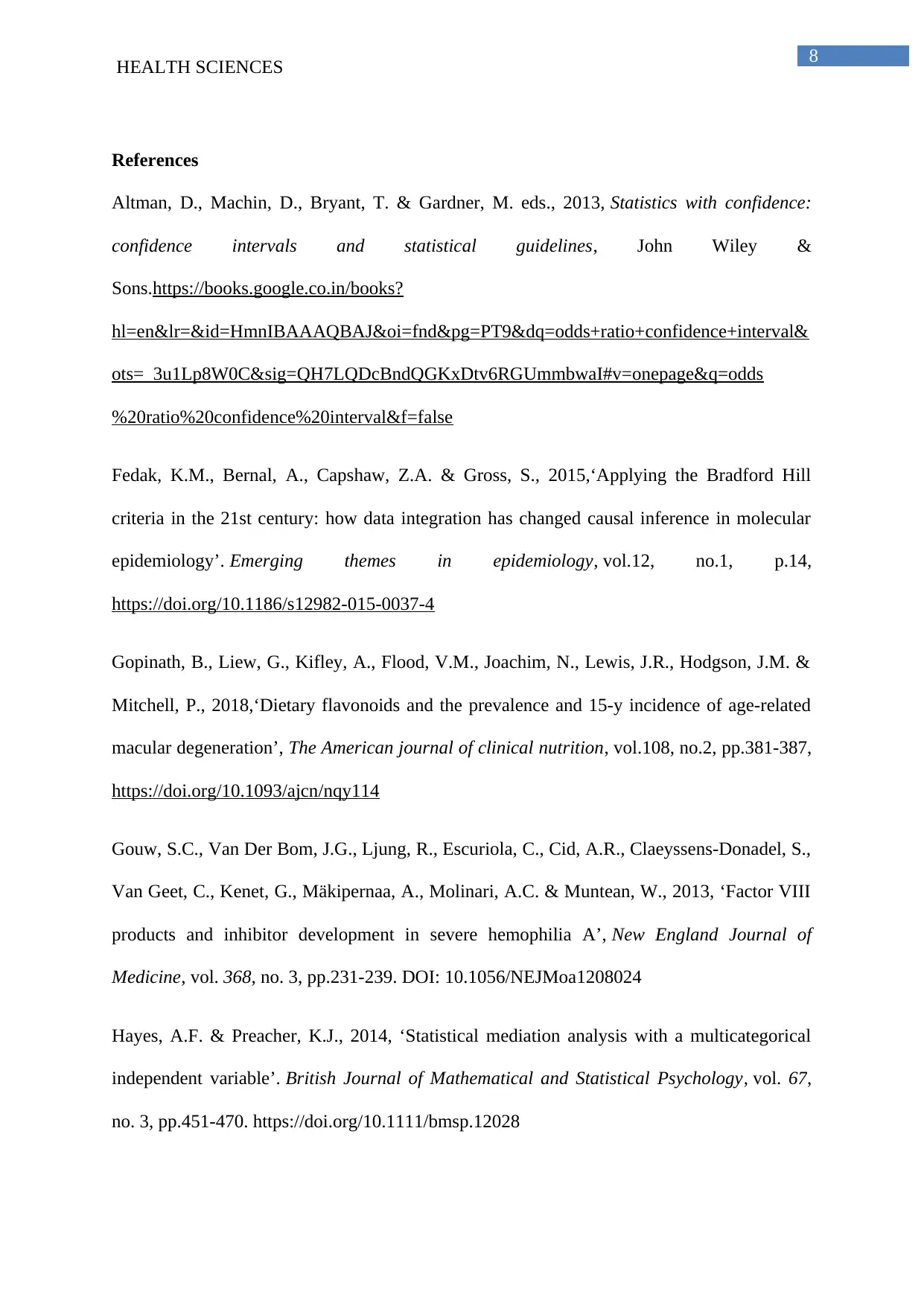
8
HEALTH SCIENCES
References
Altman, D., Machin, D., Bryant, T. & Gardner, M. eds., 2013, Statistics with confidence:
confidence intervals and statistical guidelines, John Wiley &
Sons.https://books.google.co.in/books?
hl=en&lr=&id=HmnIBAAAQBAJ&oi=fnd&pg=PT9&dq=odds+ratio+confidence+interval&
ots=_3u1Lp8W0C&sig=QH7LQDcBndQGKxDtv6RGUmmbwaI#v=onepage&q=odds
%20ratio%20confidence%20interval&f=false
Fedak, K.M., Bernal, A., Capshaw, Z.A. & Gross, S., 2015,‘Applying the Bradford Hill
criteria in the 21st century: how data integration has changed causal inference in molecular
epidemiology’. Emerging themes in epidemiology, vol.12, no.1, p.14,
https://doi.org/10.1186/s12982-015-0037-4
Gopinath, B., Liew, G., Kifley, A., Flood, V.M., Joachim, N., Lewis, J.R., Hodgson, J.M. &
Mitchell, P., 2018,‘Dietary flavonoids and the prevalence and 15-y incidence of age-related
macular degeneration’, The American journal of clinical nutrition, vol.108, no.2, pp.381-387,
https://doi.org/10.1093/ajcn/nqy114
Gouw, S.C., Van Der Bom, J.G., Ljung, R., Escuriola, C., Cid, A.R., Claeyssens-Donadel, S.,
Van Geet, C., Kenet, G., Mäkipernaa, A., Molinari, A.C. & Muntean, W., 2013, ‘Factor VIII
products and inhibitor development in severe hemophilia A’, New England Journal of
Medicine, vol. 368, no. 3, pp.231-239. DOI: 10.1056/NEJMoa1208024
Hayes, A.F. & Preacher, K.J., 2014, ‘Statistical mediation analysis with a multicategorical
independent variable’. British Journal of Mathematical and Statistical Psychology, vol. 67,
no. 3, pp.451-470. https://doi.org/10.1111/bmsp.12028
HEALTH SCIENCES
References
Altman, D., Machin, D., Bryant, T. & Gardner, M. eds., 2013, Statistics with confidence:
confidence intervals and statistical guidelines, John Wiley &
Sons.https://books.google.co.in/books?
hl=en&lr=&id=HmnIBAAAQBAJ&oi=fnd&pg=PT9&dq=odds+ratio+confidence+interval&
ots=_3u1Lp8W0C&sig=QH7LQDcBndQGKxDtv6RGUmmbwaI#v=onepage&q=odds
%20ratio%20confidence%20interval&f=false
Fedak, K.M., Bernal, A., Capshaw, Z.A. & Gross, S., 2015,‘Applying the Bradford Hill
criteria in the 21st century: how data integration has changed causal inference in molecular
epidemiology’. Emerging themes in epidemiology, vol.12, no.1, p.14,
https://doi.org/10.1186/s12982-015-0037-4
Gopinath, B., Liew, G., Kifley, A., Flood, V.M., Joachim, N., Lewis, J.R., Hodgson, J.M. &
Mitchell, P., 2018,‘Dietary flavonoids and the prevalence and 15-y incidence of age-related
macular degeneration’, The American journal of clinical nutrition, vol.108, no.2, pp.381-387,
https://doi.org/10.1093/ajcn/nqy114
Gouw, S.C., Van Der Bom, J.G., Ljung, R., Escuriola, C., Cid, A.R., Claeyssens-Donadel, S.,
Van Geet, C., Kenet, G., Mäkipernaa, A., Molinari, A.C. & Muntean, W., 2013, ‘Factor VIII
products and inhibitor development in severe hemophilia A’, New England Journal of
Medicine, vol. 368, no. 3, pp.231-239. DOI: 10.1056/NEJMoa1208024
Hayes, A.F. & Preacher, K.J., 2014, ‘Statistical mediation analysis with a multicategorical
independent variable’. British Journal of Mathematical and Statistical Psychology, vol. 67,
no. 3, pp.451-470. https://doi.org/10.1111/bmsp.12028
⊘ This is a preview!⊘
Do you want full access?
Subscribe today to unlock all pages.

Trusted by 1+ million students worldwide
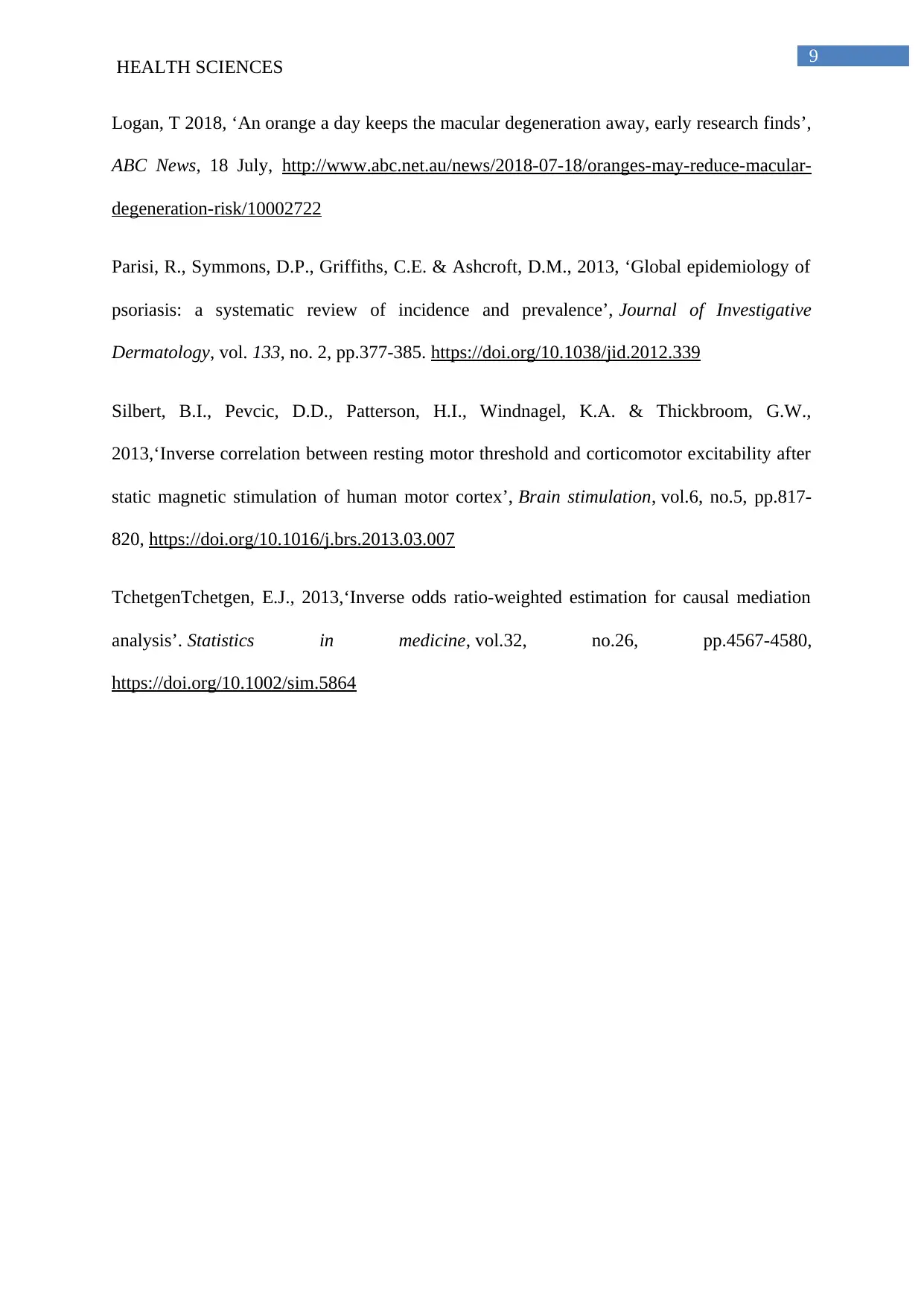
9
HEALTH SCIENCES
Logan, T 2018, ‘An orange a day keeps the macular degeneration away, early research finds’,
ABC News, 18 July, http://www.abc.net.au/news/2018-07-18/oranges-may-reduce-macular-
degeneration-risk/10002722
Parisi, R., Symmons, D.P., Griffiths, C.E. & Ashcroft, D.M., 2013, ‘Global epidemiology of
psoriasis: a systematic review of incidence and prevalence’, Journal of Investigative
Dermatology, vol. 133, no. 2, pp.377-385. https://doi.org/10.1038/jid.2012.339
Silbert, B.I., Pevcic, D.D., Patterson, H.I., Windnagel, K.A. & Thickbroom, G.W.,
2013,‘Inverse correlation between resting motor threshold and corticomotor excitability after
static magnetic stimulation of human motor cortex’, Brain stimulation, vol.6, no.5, pp.817-
820, https://doi.org/10.1016/j.brs.2013.03.007
TchetgenTchetgen, E.J., 2013,‘Inverse odds ratio‐weighted estimation for causal mediation
analysis’. Statistics in medicine, vol.32, no.26, pp.4567-4580,
https://doi.org/10.1002/sim.5864
HEALTH SCIENCES
Logan, T 2018, ‘An orange a day keeps the macular degeneration away, early research finds’,
ABC News, 18 July, http://www.abc.net.au/news/2018-07-18/oranges-may-reduce-macular-
degeneration-risk/10002722
Parisi, R., Symmons, D.P., Griffiths, C.E. & Ashcroft, D.M., 2013, ‘Global epidemiology of
psoriasis: a systematic review of incidence and prevalence’, Journal of Investigative
Dermatology, vol. 133, no. 2, pp.377-385. https://doi.org/10.1038/jid.2012.339
Silbert, B.I., Pevcic, D.D., Patterson, H.I., Windnagel, K.A. & Thickbroom, G.W.,
2013,‘Inverse correlation between resting motor threshold and corticomotor excitability after
static magnetic stimulation of human motor cortex’, Brain stimulation, vol.6, no.5, pp.817-
820, https://doi.org/10.1016/j.brs.2013.03.007
TchetgenTchetgen, E.J., 2013,‘Inverse odds ratio‐weighted estimation for causal mediation
analysis’. Statistics in medicine, vol.32, no.26, pp.4567-4580,
https://doi.org/10.1002/sim.5864
1 out of 10
Your All-in-One AI-Powered Toolkit for Academic Success.
+13062052269
info@desklib.com
Available 24*7 on WhatsApp / Email
![[object Object]](/_next/static/media/star-bottom.7253800d.svg)
Unlock your academic potential
Copyright © 2020–2025 A2Z Services. All Rights Reserved. Developed and managed by ZUCOL.

